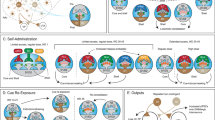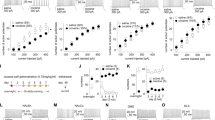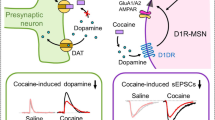Abstract
The nucleus accumbens (NAc) in the ventral striatum integrates many neurochemical inputs including dopamine and serotonin projections from midbrain nuclei to modulate drug reward. Although D1 and D2 dopamine receptors are differentially expressed in the direct and indirect pathway medium spiny neurons (dMSNs and iMSNs, respectively), 5-HT6 receptors are expressed in both pathways, more strongly than anywhere else in the brain, and are an intriguing target for neuropsychiatric disorders. In the present study, we used viral vectors utilizing dynorphin or enkephalin promoters to drive expression of 5-HT6 receptors or green fluorescent protein (GFP) selectively in the dMSNs or iMSNs of the NAc shell. Rats were then trained to self-administer cocaine. Increased 5-HT6 receptor expression in dMSNs did not change any parameter of cocaine self-administration measured. However, increasing 5-HT6 receptors in iMSNs reduced the amount of cocaine self-administered under fixed-ratio schedules, especially at low doses, increased the time to the first response and the length of the inter-infusion interval, but did not alter motivation as measured by progressive ratio ‘break point’ analysis. Modeling of cocaine pharmacokinetics in NAc showed that increased 5-HT6 receptors in iMSNs reduced the rat’s preferred tissue cocaine concentration at each dose. Finally, increased 5-HT6 receptors in iMSNs facilitated conditioned place preference for a low dose of cocaine. We conclude that 5-HT6 receptors in iMSNs of NAcSh increase the sensitivity to the reinforcing properties of cocaine, particularly at low doses, suggesting that these receptors may be a therapeutic target for the treatment of cocaine addiction.
Similar content being viewed by others
Log in or create a free account to read this content
Gain free access to this article, as well as selected content from this journal and more on nature.com
or
References
Andrews C, Lucki I (2001). Effects of cocaine on extracellular dopamine and serotonin levels in the nucleus accumbens. Psychopharmacology (Berl) 155: 221–229.
Barot SK, Ferguson SM, Neumaier JF (2007). 5-HT1B receptors in nucleus accumbens efferents enhance both rewarding and aversive effects of cocaine. Eur J Neurosci 25: 3125–3131.
Belin D, Balado E, Piazza PV, Deroche-Gamonet V (2009). Pattern of intake and drug craving predict the development of cocaine addiction-like behavior in rats. Biol Psychiatry 65: 863–868.
Belin D, Berson N, Balado E, Piazza PV, Deroche-Gamonet V (2011). High-novelty-preference rats are predisposed to compulsive cocaine self-administration. Neuropsychopharmacology 36: 569–579.
Bock R, Shin JH, Kaplan AR, Dobi A, Markey E, Kramer PF et al (2013). Strengthening the accumbal indirect pathway promotes resilience to compulsive cocaine use. Nat Neurosci 16: 632–638.
Chandra R, Francis TC, Konkalmatt P, Amgalan A, Gancarz AM, Dietz DM et al (2015). Opposing role for Egr3 in nucleus accumbens cell subtypes in cocaine action. J Neurosci 35: 7927–7937.
de Bruin NMWJ, McCreary AC, van Loevezijn A, de Vries TJ, Venhorst J, van Drimmelen M et al (2013). A novel highly selective 5-HT6 receptor antagonist attenuates ethanol and nicotine seeking but does not affect inhibitory response control in Wistar rats. Behav Brain Res 236: 157–165.
Dobi A, Seabold GK, Christensen CH, Bock R, Alvarez VA (2011). Cocaine-induced plasticity in the nucleus accumbens is cell specific and develops without prolonged withdrawal. J Neurosci 31: 1895–1904.
Dölen G, Darvishzadeh A, Huang KW, Malenka RC (2013). Social reward requires coordinated activity of nucleus accumbens oxytocin and serotonin. Nature 501: 179–184.
Eskenazi D, Brodsky M, Neumaier JF (2015a). Deconstructing 5-HT6 receptor effects on striatal circuit function. Neuroscience 299: 97–106.
Eskenazi D, Brodsky M, Neumaier JF (2015b). Deconstructing 5-HT6 receptor effects on striatal circuit function. Neuroscience 299: 97–106.
Eskenazi D, Neumaier JF (2011a). Increased expression of the 5-HT6 receptor by viral mediated gene transfer into posterior but not anterior dorsomedial striatum interferes with acquisition of a discrete action-outcome task. J Psychopharmacol 25: 944–951.
Eskenazi D, Neumaier JF (2011b). Increased expression of 5-HT6 receptors in dorsolateral striatum decreases habitual lever pressing, but does not affect learning acquisition of simple operant tasks in rats. Eur J Neurosci 34: 343–351.
Ettenberg A (2004). Opponent process properties of self-administered cocaine. Neurosci Biobehav Rev 27: 721–728.
Ferguson SM, Eskenazi D, Ishikawa M, Wanat MJ, Phillips PEM, Dong Y et al (2011). Transient neuronal inhibition reveals opposing roles of indirect and direct pathways in sensitization. Nat Neurosci 14: 22–24.
Ferguson SM, Mitchell ES, Neumaier JF (2008). Increased expression of 5-HT6 receptors in the nucleus accumbens blocks the rewarding but not psychomotor activating properties of cocaine. Biol Psychiatry 63: 207–213.
Ferguson SM, Phillips PEM, Roth BL, Wess J, Neumaier JF (2013). Direct-pathway striatal neurons regulate the retention of decision-making strategies. J Neurosci 33: 11668–11676.
Fijal K, Pachuta A, Mccreary AC, Nowak E, Papp M, Bieñkowski P et al (2010). Effects of serotonin (5-HT) 6 receptor ligands on responding for cocaine reward and seeking in rats. Pharmacol Reports 181187: 1005–1014.
Frantz KJ, Hansson KJ, Stouffer DG, Parsons LH (2002). 5-HT 6 receptor antagonism potentiates the behavioral and neurochemical effects of amphetamine but not cocaine. Neuropharmacology 42: 170–180.
Gerfen CR, Engber TM, Mahan LC, Susel Z, Chase TN, Monsma FJ et al (1990). D1 and D2 dopamine receptor-regulated gene expression of striatonigral and striatopallidal neurons. Science 250: 1429–1432.
Gerfen CR, McGinty JF, Young WS (1991). Dopamine differentially regulates dynorphin, substance P, and enkephalin expression in striatal neurons: in situ hybridization histochemical analysis. J Neurosci 11: 1016–1031.
Hikida T, Kimura K, Wada N, Funabiki K, Nakanishi S (2010). Distinct roles of synaptic transmission in direct and indirect striatal pathways to reward and aversive behavior. Neuron 66: 896–907.
Hirst WD, Abrahamsen B, Blaney FE, Calver AR, Aloj L, Price GW et al (2003). Differences in the central nervous system distribution and pharmacology of the mouse 5-hydroxytryptamine-6 receptor compared with rat and human receptors investigated by radioligand binding, site-directed mutagenesis, and molecular modeling. Mol Pharmacol 64: 1295–1308.
Hyman SE, Malenka RC, Nestler EJ (2006). Neural mechanisms of addiction: the role of reward-related learning and memory. Annu Rev Neurosci 29: 565–598.
Macpherson T, Morita M, Hikida T (2014). Striatal direct and indirect pathways control decision-making behavior. Front Psychol 5: 1–7.
McDevitt Ra, Tiran-Cappello A, Shen H, Balderas I, Britt JP, Marino RAM et al (2014). Serotonergic versus nonserotonergic dorsal raphe projection neurons: differential participation in reward circuitry. Cell Rep 8: 1857–1869.
Michaelides M, Anderson SAR, Ananth M, Smirnov D, Thanos PK, Neumaier JF et al (2013). Whole-brain circuit dissection in free-moving animals reveals cell-specific mesocorticolimbic networks. J Clin Invest 123: 5342–5350.
Mitchell ES, Neumaier JF (2008). 5-HT6 receptor antagonist reversal of emotional learning and prepulse inhibition deficits induced by apomorphine or scopolamine. Pharmacol Biochem Behav 88: 291–298.
Mitchell ES, Sexton T, Neumaier JF (2007). Increased expression of 5-HT6 receptors in the rat dorsomedial striatum impairs instrumental learning. Neuropsychopharmacology 32: 1520–1530.
Müller CP, Homberg JR (2015). The role of serotonin in drug use and addiction. Behav Brain Res 277: 146–192.
Nair SG, Furay AR, Liu Y, Neumaier JF (2013). Differential effect of viral overexpression of nucleus accumbens shell 5-HT1B receptors on stress- and cocaine priming-induced reinstatement of cocaine seeking. Pharmacol Biochem Behav 112: 89–95.
Neumaier JF, Vincow ES, Arvanitogiannis A, Wise RA, Carlezon WA (2002). Elevated expression of 5-HT 1B receptors in nucleus accumbens efferents sensitizes animals to cocaine. J Neurosci 22: 10856–10863.
Pan H-T, Menacherry S, Justice JB (1991). Differences in the pharmacokinetics of cocaine in naive and cocaine-experienced rats. J Neurochem 56: 1299–1306.
Parsons LH, Justice JB (1993a). Perfusate serotonin increases extracellular dopamine in the nucleus accumbens as measured by in vivo microdialysis. Brain Res 606: 195–199.
Parsons LH, Justice JB (1993b). Serotonin and dopamine sensitization in the nucleus accumbens, ventral tegmental area, and dorsal raphe nucleus following repeated cocaine administration. J Neurochem 61: 1611–1619.
Pliakas AM, Carlson RR, Neve RL, Konradi C, Nestler EJ, Carlezon WA (2001). Altered responsiveness to cocaine and increased immobility in the forced swim test associated with elevated cAMP response element-binding protein expression in nucleus accumbens. J Neurosci 21: 7397–7403.
Rehm J, Mathers C, Popova S, Thavorncharoensap M, Teerawattananon Y, Patra J (2009). Global burden of disease and injury and economic cost attributable to alcohol use and alcohol-use disorders. Lancet 373: 2223–2233.
Richardson NR, Roberts DCS (1996). Progressive ratio schedules in drug self-administration studies in rats: a method to evaluate reinforcing efficacy. J Neurosci Methods 66: 1–11.
Sora I, Hall FS, Andrews AM, Itokawa M, Li XF, Wei HB et al (2001). Molecular mechanisms of cocaine reward: combined dopamine and serotonin transporter knockouts eliminate cocaine place preference. Proc Natl Acad Sci USA 98: 5300–5305.
Stuber GD, Sparta DR, Stamatakis AM, van Leeuwen WA, Hardjoprajitno JE, Cho S et al (2011). Excitatory transmission from the amygdala to nucleus accumbens facilitates reward seeking. Nature 475: 377–380.
Surmeier DJ, Ding J, Day M, Wang Z, Shen W (2007). D1 and D2 dopamine-receptor modulation of striatal glutamatergic signaling in striatal medium spiny neurons. Trends Neurosci 30: 228–235.
Tassone A, Madeo G, Schirinzi T, Vita D, Puglisi F, Ponterio G et al (2011). Activation of 5-HT6 receptors inhibits corticostriatal glutamatergic transmission. Neuropharmacology 61: 632–637.
Tzschentke TM (1998). Measuring reward with the conditioned place preference paradigm: a comprehensive review of drug effects, recent progress and new issues. Prog Neurobiol 56: 613–672.
US Department of Justice National Drug Intelligence Center (2011). National Drug Threat Assessment 2011. 1–72 doi:doi:10.1037/e618352012-001.
Uchimura N, North R (1990). Actions of cocaine on rat nucleus accumbens neurones in vitro. Br J Pharmacol 740: 736–740.
United States Department of Health and Human Services (2014). The Health Consequences of Smoking—50 years of progress: a report of the Surgeon General. Rep Surg Gen 1081.
Valentini V, Piras G, De Luca MA, Perra V, Bordi F, Borsini F et al (2012). Evidence for a role of a dopamine/5-HT6 receptor interaction in cocaine reinforcement. Neuropharmacology 65C: 58–64.
van Gaalen MM, Schetters D, Schoffelmeer ANM, De Vries TJ (2010). 5-HT6 antagonism attenuates cue-induced relapse to cocaine seeking without affecting cocaine reinforcement. Int J Neuropsychopharmacol 13: 961–965.
Ward R, Hamblin M, Lachowicz J, Hoffman BJ, Sibley DR, Dorsa DM (1995). Localization of serotonin subtype 6 receptor messenger RNA in the rat brain by in situ hybridization histochemistry. Neuroscience 64: 1105–1111.
Yager LM, Garcia AF, Wunsch AM, Ferguson SM (2015). The ins and outs of the striatum: role in drug addiction. Neuroscience 301: 529–541.
Zimmer BA, Dobrin CV, Roberts DCS (2011). Brain-cocaine concentrations determine the dose self-administered by rats on a novel behaviorally dependent dosing schedule. Neuropsychopharmacology 36: 2741–2749.
Acknowledgements
Support for this work was funded by NIDA Training Grant T32-DA00007278 (MB), R01DA030807 (JFN) and R21DA034192 (SGN). We gratefully acknowledge the technical support offered by Michele Kelly, Scott Ng-Evans, and Adam Lesiak. We thank David Roberts for providing the software program to estimate tissue cocaine concentrations.
Author information
Authors and Affiliations
Corresponding author
Additional information
Supplementary Information accompanies the paper on the Neuropsychopharmacology website
Rights and permissions
About this article
Cite this article
Brodsky, M., Gibson, A., Smirnov, D. et al. Striatal 5-HT6 Receptors Regulate Cocaine Reinforcement in a Pathway-Selective Manner. Neuropsychopharmacol 41, 2377–2387 (2016). https://doi.org/10.1038/npp.2016.45
Received:
Revised:
Accepted:
Published:
Issue date:
DOI: https://doi.org/10.1038/npp.2016.45



